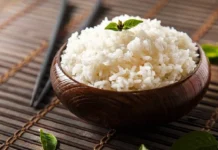Bell peppers, a member of the Capsicum annuum species, are distinct from their spicy chili pepper cousins as they lack capsaicin, resulting in a sweet flavor. They come in a variety of colors, including green, yellow, orange, and red, and are highly nutritious. Bell peppers are composed mostly of water (92%), with the remaining consisting of carbs, proteins, and small amounts of fat. They are also a good source of minerals and vitamins.
The carbs in bell peppers come primarily from glucose and fructose, which lend a natural sweetness when ripe. They also provide energy for the body. Notably, bell peppers are an excellent source of vitamin C, with a single pepper meeting up to 169% of the daily requirement. Additionally, they contain about 2% fiber, which aids in efficient digestion.
Bell peppers are also rich in vitamin K1, vitamin A, folate, and potassium. They boast a particularly high content of antioxidants, especially carotenoids, which are abundant in ripe peppers. Two important carotenoids, lutein and zeaxanthin, help protect the retina from oxidative damage. A 2020 study indicated that orange bell peppers are rich in zeaxanthin, while yellow peppers are abundant in lutein, both of which reduce the risk of cataracts, macular degeneration, and vision loss.
Red bell peppers are especially noteworthy for their iron and vitamin C content. The vitamin C enhances iron absorption in the intestines, helping to prevent anemia, which is a common concern for women during adolescence. Given these benefits, bell peppers offer significant health advantages, some of which are detailed below:
**Kidney Detox Support:**
Bell peppers are a good source of vitamin C, A, and antioxidants, which have anti-inflammatory properties and protect kidney cells from damage. The lycopene in red bell peppers is particularly effective in preventing chronic kidney disease. Consuming bell peppers raw, cooked, or in salads ensures maximum nutrient absorption.

Bell peppers are rich in vitamins C, A, and antioxidants, offering anti-inflammatory benefits and protecting kidney cells from damage.
**Exceptional Source of Vitamin C:**
Bell peppers, particularly the red variety, are an excellent source of vitamin C, which plays a crucial role in boosting immunity. This is especially beneficial during winter when colds and flu are prevalent. Incorporating bell peppers into meals helps the body prevent illnesses and expedite recovery. A single medium-sized red bell pepper provides up to 150% of the daily vitamin C requirement.
**Cholesterol Reduction:**
Bell peppers contain capsaicin, a compound known for lowering “bad” LDL cholesterol, managing diabetes, alleviating pain, and combating inflammation. With approximately 3g of fiber per pepper, bell peppers also aid digestion and help maintain stable cholesterol levels in the body.
**Natural Antioxidant Source:**
Bell peppers are packed with antioxidants such as carotenoids (including beta-carotene, lutein, and zeaxanthin). These are especially beneficial during winter, when skin is more susceptible to harsh weather conditions. Antioxidants neutralize free radicals, reducing oxidative stress and inflammation. They also shield the skin from UV damage, even with limited sun exposure. Including bell peppers in your diet supports skin health, slows down aging, and protects against chronic diseases by minimizing free radical damage.
**Cardiovascular Protection and Varicose Vein Prevention:**
Bell peppers contain lycopene, a carotenoid that safeguards cardiovascular health, helps prevent strokes, regulates blood pressure, and balances cholesterol levels. Additionally, capsaicin exhibits antioxidant properties, contributing to cancer prevention and immune regulation, while also inhibiting the development of varicose veins and blood clots.
**Digestive Support and Fiber Content:**
Bell peppers are an excellent source of fiber, promoting digestion and preventing constipation, a common issue during winter due to unbalanced diets. Fiber ensures efficient digestive function, enhances gut health, and sustains a feeling of fullness, thereby aiding in weight management.

Bell peppers are a rich source of fiber, aiding digestion and preventing constipation, a common winter concern due to unbalanced diets.
**Effective Cancer Prevention:**
Red bell peppers contain antioxidant compounds like lycopene, which help neutralize free radicals from the environment, thereby reducing the risk of certain cancers, notably prostate cancer in men. Yellow and orange bell peppers are also rich in carotenoids, benefiting cardiovascular health and overall well-being.
**Eye Health:**
The vibrant colors of bell peppers not only delight the eyes but also signify the presence of lutein and zeaxanthin, two crucial antioxidants for eye health. These compounds protect the eyes from free radical damage, which can lead to cataracts and macular degeneration over time. The dim light and shorter days of winter can strain the eyes, so a regular intake of bell peppers helps maintain healthy vision throughout the year.
**Neurological Benefits:**
Bell peppers (red, green, and yellow) are rich in B vitamins, including B1, B6, and folate (B9). These vitamins are essential for nerve signaling, enhancing brain cell connectivity, and maintaining stable brain function. They are indispensable for supporting neurological health.
**Promoting Healthy Skin:**
The cold winter air and indoor heating can leave skin dry, irritated, and cracked. Red bell peppers are particularly rich in vitamin A, which aids in skin cell regeneration and repair, retaining moisture, and protecting the skin from harsh conditions. Including bell peppers in winter meals provides essential nutrients that keep the skin soft, supple, and radiant.
**Anti-Inflammatory Properties:**
Winter can exacerbate joint inflammation and other inflammatory disorders. Bell peppers, especially the red variety, are rich in anti-inflammatory compounds due to their high content of vitamin C, A, and other antioxidants. Incorporating bell peppers into your daily diet effectively reduces inflammation and supports overall health.
Boost Your Vitamin C Intake: 5 Fruits Richer Than Oranges
Introducing the top 5 vitamin C-rich fruits that will give your immune system a powerful boost! These fruits are not your average oranges – they pack a punch when it comes to nutrition and offer a delightful twist to your daily diet. Discover the benefits of these super fruits and unlock a world of health and flavor.
The Next Big Beverage Trend: What’s the Buzz About This Ancient Drink?
Introducing the latest beauty superfood that’s set to rival matcha as the go-to drink for all wellness enthusiasts. This magical ingredient, with its captivating hues, offers more than just a pretty color – it’s a powerhouse of nutrients that will transform your beauty routine. Get ready to unlock radiant skin and vibrant health with every sip!





































